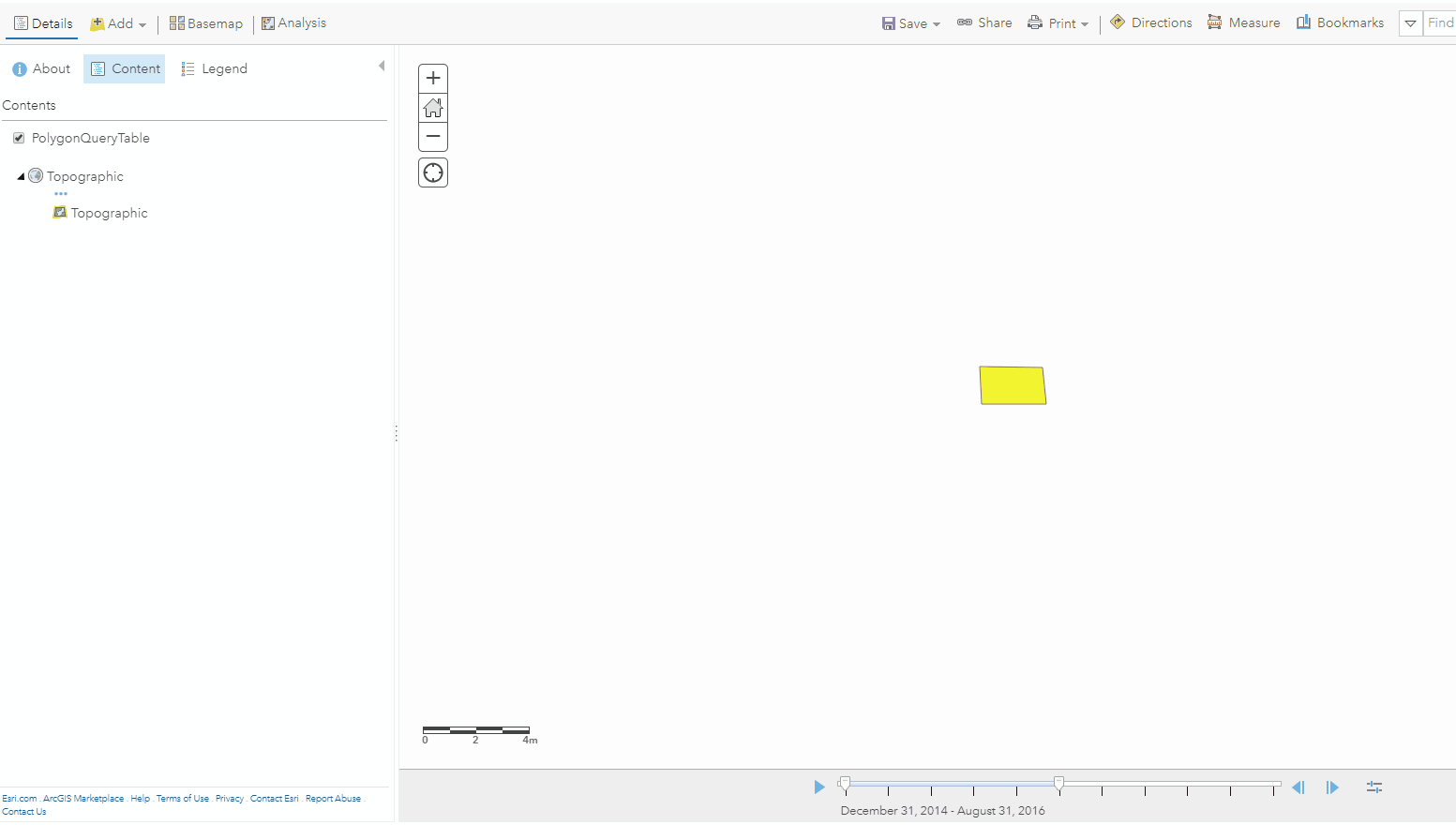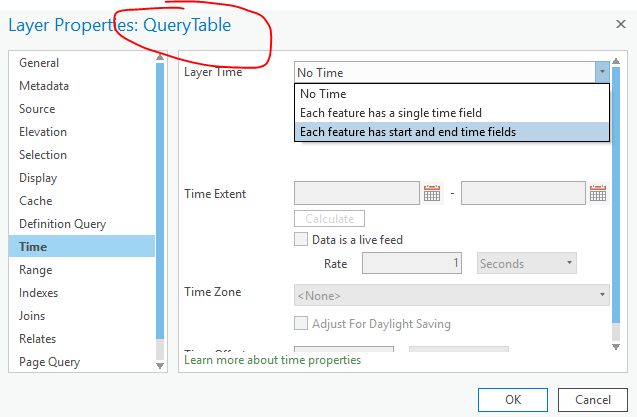- Home
- :
- All Communities
- :
- Products
- :
- ArcGIS Pro
- :
- ArcGIS Pro Questions
- :
- Re: Time Lapse question using the same data
- Subscribe to RSS Feed
- Mark Topic as New
- Mark Topic as Read
- Float this Topic for Current User
- Bookmark
- Subscribe
- Mute
- Printer Friendly Page
Time Lapse question using the same data
- Mark as New
- Bookmark
- Subscribe
- Mute
- Subscribe to RSS Feed
- Permalink
Hi Everyone,
I am hoping to make a timelapse map with some land parcels (polygons) in ArcGIS Pro to eventually show on ArcGIS Online. I have seen examples on how to best go about this but I feel like either my data is unique or what I am doing isn't normal...
Situation: I am keeping tracking of parcels along a roadway that are being affected by right-of-way acquisition. These parcels have a status field with roughly 15-20 values (in a domain) that gets updated each week or so to a new status. On the map, they are color coded based on status.
What I want: it would be nice to have 15-20 fields in my polygon/parcel that are date fields for each status and have the time lapse reader look at what status the parcel is in at a certain time based on those fields. But, I don't think that is possible (or is it?).
So, how do I do this? Do I have to make a new polygon geometry that sits on top of the old polygon with a new date for each status along the way? That would seem to get cumbersome and hard to deal with 15 polygons stacked on top of each other in the same exact spot on the same layer.
Does anyone have experience with polygons changing over time and showing that on a time lapse slider map or sorts?
Thanks!
- Mark as New
- Bookmark
- Subscribe
- Mute
- Subscribe to RSS Feed
- Permalink
Tagging Owen Evans since he wrote this article:
And tagging Kory Kramer for his ArcGIS Pro expertise in hoping to find a somewhat-answer to my query. Thanks!
- Mark as New
- Bookmark
- Subscribe
- Mute
- Subscribe to RSS Feed
- Permalink
You could maintain 1 feature class, and then have a separate table storing the attribute and update time info. This piece of doc provides a good example Examples of queries with the Make Query Table tool—Help | ArcGIS for Desktop
- Mark as New
- Bookmark
- Subscribe
- Mute
- Subscribe to RSS Feed
- Permalink
Kory,
This is great! It looks like it might be just what I need.
I haven't used a related table in AGOL yet, but I'm not sure this is the same thing.
Two questions:
1) When publishing to ArcGIS Online, does this work as expected in terms of the symbology (and I assume you have to publish the feature class and the table)? Like, would you still have to make it a "time-enabled layer" or is that not the same with a table?
2) And, when making updates to the table, do you have to go back and re-do the Make Query Table tool each time? Or is it essentially "live" after you perform the first "Make Query Table" function?
- Mark as New
- Bookmark
- Subscribe
- Mute
- Subscribe to RSS Feed
- Permalink
Hi Adrian, I found some time to play with this a little bit and unfortunately I don't think that publishing the query table will work. Using that query table as part of the workflow might still be helpful to ultimately get the feature class created that you'll publish.
So, you could use the Make Query Table tool, but then you'll need to export that to a feature class, essentially creating a record for each time slice.
Here is a very simple, single polygon that changes status over time.
In Pro:

Publish that to ArcGIS Online:

The obvious drawback is that this won't be "live" with your status updates. You would need to overwrite the feature layer after updating statuses.
- Mark as New
- Bookmark
- Subscribe
- Mute
- Subscribe to RSS Feed
- Permalink
Adding to Kory's workflow, you could automate the publishing (overwriting) to AGOL with Updating your hosted feature services with ArcGIS Pro and the ArcGIS API for Python which would sort of give you "live" capability by running the python with Windows Task Scheduler. I have some AGOL feature services that get updated hourly in some instances, with a variety of on prem data sources such as SDE, FGDB, CSV. You could add a time stamp to a date field as part of the script.
- Mark as New
- Bookmark
- Subscribe
- Mute
- Subscribe to RSS Feed
- Permalink
Thomas,
That's a good thought. I have been wanting to get into ArcGIS API for Python and this would be a good test.
- Mark as New
- Bookmark
- Subscribe
- Mute
- Subscribe to RSS Feed
- Permalink
Thanks Kory. I appreciate you looking into this.
So, would a system work like this?
1. Have polygon layer with unique number.
2. Make table that includes unique number and all appropriate attributes, including dates.
3. Make Query Table (and set up symbology)
4. Export that Query Table to a new polygon feature class.
5. Publish feature class to AGOL.
6. When new updates occur to the table, include them, then export the table again to overwrite the existing polygon feature class, then republish.
I haven't made a query table yet (I probably should), but, two questions:
1. Does only one date field work? Or can I have a start date field AND an end date field?
2. When exporting a query table to a new feature class, does it include all the attributes of the original polygon layer and the table as one giant attribute table?
- Mark as New
- Bookmark
- Subscribe
- Mute
- Subscribe to RSS Feed
- Permalink
1. Have polygon layer with unique number. [KK: Yes, the number that will be used to associate the features to the time and status data in the stand-alone table]
2. Make table that includes unique number and all appropriate attributes, including dates. [KK: Yes. Note that each date slice is a new record in this table. e.g.
Poly1; Status1; Date1
Poly1; Status2; Date2
Poly1; Status3; Date3
3. Make Query Table (and set up symbology) [KK: Yes]
4. Export that Query Table to a new polygon feature class. [KK: Yes]
5. Publish feature class to AGOL. [KK: Yes]
6. When new updates occur to the table, include them, then export the table again to overwrite the existing polygon feature class, then republish. [KK: I'm not sure as I haven't tested, but you might need to run Make Query Table again. Not sure, you should test]
I haven't made a query table yet (I probably should), but, two questions: [KK: Yes, you need to test the workflow with your data/formats/sources...]
1. Does only one date field work? Or can I have a start date field AND an end date field? [KK: test it out. There are options on the layer.]

2. When exporting a query table to a new feature class, does it include all the attributes of the original polygon layer and the table as one giant attribute table? [KK: Yes and no. It should kind of like exporting a table with a JOIN. i.e. use field visibility to turn fields off that you don't want included in the export. I just quickly tested and there may be some exceptions when working specifically with a query table so I think you should set yours up and test]
- Mark as New
- Bookmark
- Subscribe
- Mute
- Subscribe to RSS Feed
- Permalink
Awesome.
Bottom line, I need to get this table made and then test it! I will report back when I do. Thanks y'all!